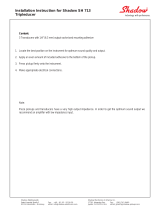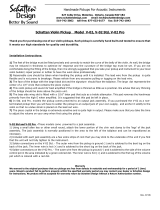Page is loading ...

1 . P A C K A G E C O N T E N T S
O n e (1) Radius transducer
Three (3) Clear adhesive pads – non-destructive
Two (2) Permanent VHB adhesive pads
O n e (1) Mounting putty
O n e (1) Output jack
O n e (1) External mounting hardware for jack
O n e (1) Manual
O n e (1) Warranty card
Tw o (2) Self stick wire hold down clips for
internal installations
2 . O V E R V I E W A N D C A U T I O N S
The “Radius” is a revolutionary new soundboard
transducer, capable of reproducing the true acoustic
tone and characteristics of your instrument. It has
been designed/tuned for use on mandolins but
can also be utilized on violins or other small framed
instruments within the same frequency range. It
installs simply and non-destructively to the top of
your mandolin with putty or a peel and stick adhesive.
This adhesive will hold rmly to the instrument while
remaining pliable and easily removable.
Caution: For more delicate nishes like violin or
if you are at all concerned about nish safety we
have provided a special putty to use in place of the
adhesive pad.
3 . Q U I C K S T A R T
• Attach removable jack/clamp to the side of the
instrument following the instructions in 4.1.
• Put a dab of putty on the underside of the Radius
and smoosh the pickup onto the instrument top
behind the treble side of the bridge; (see g. 1 for
recommend placement).
• Plug in and go.
• Reposition the Radius around on the top until
you’ve found the sweet spot.
• If you wish to make the installation permanent
follow the instructions below.
4 . I N S T A L L A T I O N
First choose where you will install the jack. We oer
two options: 1) Non-permanently mounted on
the side of the instrument using the pre-soldered
clamp/jack or, 2) Permanent tailpiece installation.
The pickup comes pre-soldered to the clamp/jack so
that you may quickly and easily install the pickup for
immediate results. The wire is longer than necessary
to allow for alternate installations. You can choose to
either tuck the excess wire under the tailpiece or cut
it to the preferred length and re-solder it.
4.1 Non-permanent external clamp/jack
installation: Open the jaws of the clamp until it
ts comfortably over the side of the instrument by
turning the threaded adjusters counter clockwise
(See g. 2). Set the jack/clamp in place with the
protective cork pads completely covering the
upper and lower edges of the instrument. Using
the enclosed key gradually tighten the adjusters,
alternating between the left and right side until the
clamp is securely fastened (See g. 1 for recommend
jack placement). Be careful not to scratch the
instruments nish with the key.
4.2 Pickup Placement: The pickup may be installed
one of three ways: On the top with mounting putty,
on the top with non-destructive double stick
adhesive, or internally with semi-permanent VHB
adhesive.
• First, nd the sweet spot. With freshly cleaned
ngers, tear o a dab of the putty (included), and
spread it on the entire bottom surface of the pickup.
The Radius is rather lenient for placement, but
we recommend you begin behind the bridge on
the treble side of the top (See g. 1). Make sure to
thoroughly clean all dust, oil, and ngerprints o of
the top of the instrument prior to installing the pickup.
Set the pickup onto the top of the instrument in the
recommended area and apply moderate pressure
twisting it back and fourth until it feels secure. Now
plug the pickup in to a high quality acoustic amplier
or PA and listen. Experiment with placement until
you nd the best location/sweet spot. Once you
have chosen a location you may replace the putty
with the clear double stick adhesive (included) for a
more secure installation, or if you like you can keep
the putty as the nal install. Note: The longevity of the

putty’s holding ability is unknown. At some point you
might need to replace it with some fresh putty, so make
sure to keep some on hand in case.
• The pickup can be installed on the inside surface
of the instrument. We have included special VHB
adhesive for this purpose. If you choose this option,
make sure the surface where you install the pickup is
clean of all foreign matter. Also we strongly suggest
that you rst nd the sweet spot for the installation
using the putty on the top of the instrument before
adhering it inside.
4.3 Permanent tailpiece jack installation for
standard or common style mandolin tailpieces:
First remove the jack from the clamping hardware
and de-solder the pickup. Also remove the shielding
cap, at and star washers, and nut from the large
threaded section of the jack. You will only need the
single at washer and nut from the small end of the
jack for this option. Note: there is a 1 meg ohm resistor
R ADIUS
™
I N S T A L L A T I O N M A N U A L
& U S E R S G U I D E
4 8 3 N . F R O N T A G E R D .
N I P O M O , C A 9 3 4 4 4
P H O N E 8 0 5 · 9 2 9 · 3 5 4 5
soldered to the jack between the tip and ground lugs
– it is important for the performance of the pickup to
leave the resistor soldered in place.
• Remove the strap pin and the three mounting
screws holding the metal tailpiece in place.
Remove the tailpiece.
• Drill a 1/2” hole in the tail block, using the strap-pin
hole as a pilot hole.
• Drill or ream out the strap-pin hole in the metal
tailpiece to 3/8” for the small end of the jack to slip
through.
• Attach the jack to the tailpiece as follows: Remove
the nut and washer from the end of the jack, slip
the end through the hole in the tailpiece, then put
the washer and nut back on and tighten the nut to
secure it to the tailpiece. Screw on the strap ring
(See g 3).
• Feed the pickup wire through the F-hole and sh
it out of the hole in the tailblock with a makeshift
hook. You should have about 4 inches of wire to
work with sticking out of the tailpiece. Make sure
you leave the wire long enough to be able to move
it around on the top of the instrument to locate
the sweet spot after the jack has been installed.
• Before you solder, slide the shielding cap over the
wire, back side rst. If you do not want to use the
shielding cap you can shield the connection with
copper shielding tape (if you choose this option
be sure to insulate the hot lead before applying
the shielding tape. Also, for the shielding tape to
be eective solder a small section of it to a portion
of the ground lug on the jack).
• Solder the inner lead wire to the tip lug of the jack
(See g. 3).
• Solder the braided wire to the ground tab of the
jack (See g. 3).
• Shield the connection now by either screwing on
the shielding cap or applying the copper shielding
tape.
• Slide the entire assembly into the hole in the
tailblock, secure the tailpiece with the three
mounting screws, and you’re done.
5. P E R F O R M A N C E R E CO M M E N DAT I O N S
The Radius is a high impedance transducer. Although
it has enough output to drive most ampliers,
or PA line inputs, for best results we recommend
running it through a high quality pre/amp with a
minimum input impedance of 2.2 meg. Ohm. The
Radius is reasonably free fro m feedback in common
environments but any body sensitive transducer
can feed back at high enough SPL levels. If you are
experiencing feedback we recommend either the
Para Acoustic DI or Feedback Master.
/



